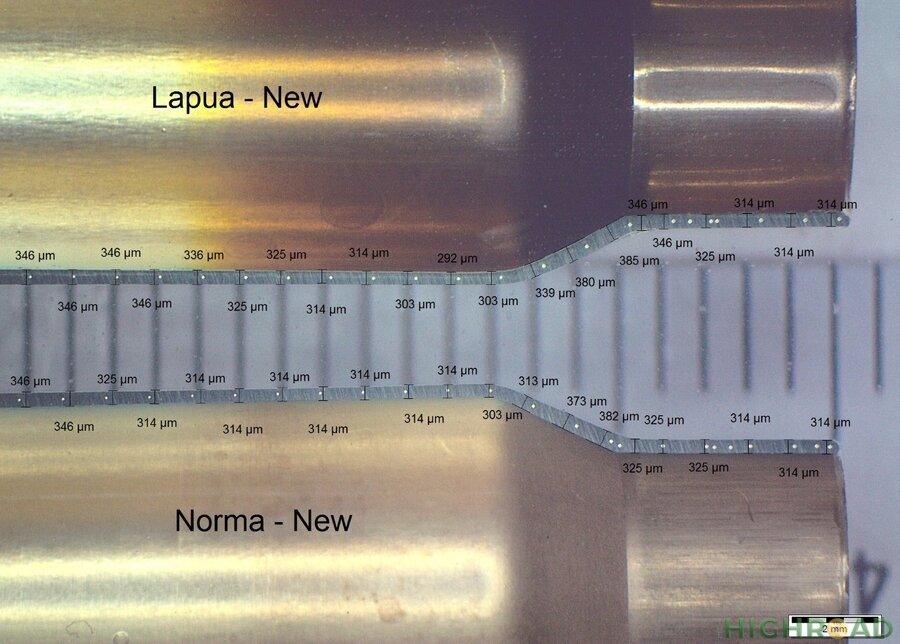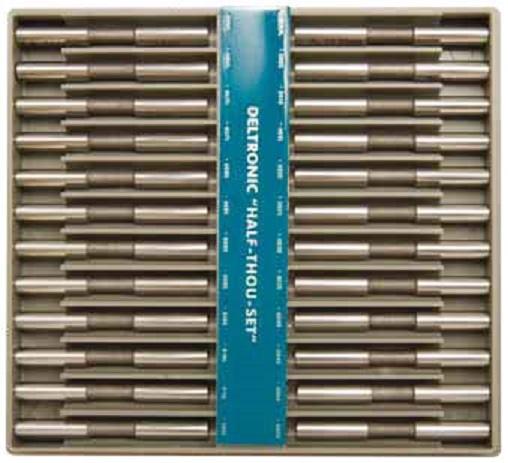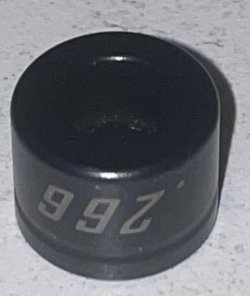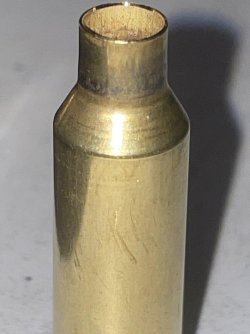Donuts only become a problem when you size all the way down to the neck/ shoulder junction. If you don't size it, they stay larger than the bullet. I use the neck bushings made by short action customs. They have a tapered cone ( more of a chamfer) at the bottom and even when screwed down tight, they never touch the neck/shoulder junction. They cannot shave brass off the neck (like Redding bushings do) Plus they are guaranteed to produce sized cases with less run out than any of other bushings made. I don't know if it shows up well in the photo, but I can see sizing stops about 30-thou short of where the donut forms.
You are using an out of date browser. It may not display this or other websites correctly.
You should upgrade or use an alternative browser.
You should upgrade or use an alternative browser.
donuts to go
- Thread starter Idgunner
- Start date
 Help Support Long Range Hunting Forum
Help Support Long Range Hunting Forum
Mikecr
Well-Known Member
Pdyson, you don't even need to size that much of the neck.
I would back off the bushing to size maybe half the neck length or less. NEVER more than seated bullet bearing.
I would back off the bushing to size maybe half the neck length or less. NEVER more than seated bullet bearing.
I know you mean to lengthen the throat. Both barrels are chambered with my custom reamer that has almost no throat. As it is unless I go to a single manual feed ramp the magazine length is not there.If they are 'your dedicated varmint rifles'...
Why not lenghten the chamber to seat the bullets out further.....
Order a reamer to use..hand cut the lenght you need to get your bullets seated front of the neck/shoulder jct.....
Yep, I'm using SAC bushings. I think I'm going to short size the necks and see what happens.Donuts only become a problem when you size all the way down to the neck/ shoulder junction. If you don't size it, they stay larger than the bullet. I use the neck bushings made by short action customs. They have a tapered cone ( more of a chamfer) at the bottom and even when screwed down tight, they never touch the neck/shoulder junction. They cannot shave brass off the neck (like Redding bushings do) Plus they are guaranteed to produce sized cases with less run out than any of other bushings made. I don't know if it shows up well in the photo, but I can see sizing stops about 30-thou short of where the donut forms.
Doughnuts seem to grow in size over time, I have seen some that are quite thick.
Cut the doughnut out, or save the doughnut cases in a batch to deal with later.
Brass varies in hardness over the lot#, and I suspect that the softer brass of the lot has doughnuts sooner.
Cut the doughnut out, or save the doughnut cases in a batch to deal with later.
Brass varies in hardness over the lot#, and I suspect that the softer brass of the lot has doughnuts sooner.
Barrelnut
Well-Known Member
This and a sharp shoulder.Brass varies in hardness over the lot#, and I suspect that the softer brass of the lot has doughnuts sooner.
The donut seems to come with all 223/5.56 brass. At times, almost impossible to pull the expander out of the lubed necks.
The fix is outside neck turning. Only takes one turning. Best part is, i can still use my standard RCBS FL die, as is.

The fix is outside neck turning. Only takes one turning. Best part is, i can still use my standard RCBS FL die, as is.
Well I tried backing off of my neck size bushing to reduce the depth I was sizing the necks. By doing that the number of hard donuts that I felt when seating bullets dropped quite a bit. But I can still feel that donut on most cases so I've decided to buy an L.E.Wilson case trimmer with a neck reamer. I've boxed up a sample of my fired Lapua cases and will mail them to Wilson tomorrow. I just want to feel nice smooth seating pressure all the way to the bottom of the seating stroke and hopefully attain better accuracy.
ntsqd
Well-Known Member
Tagging in to learn more.
Thought that I'd mention that both MSC-Direct and Travers also offer the gauge pins, usually at lower prices. For true machining tools it's worth knowing about both of these vendors.
Quote:
snipped.....
In the meantime, I would suggest that you insert a bullet into each case after being fired. There may be enough clearance for you to slip a bullet down past the shoulder-neck junction. As you find a case with doughnuts, cull them aside and deal with them later as you figure out your style of dealing with this issue. If you do not have the clearance after firing to slip a bullet down the neck, then McMaster Carr sells pin gauges you can use.
Thought that I'd mention that both MSC-Direct and Travers also offer the gauge pins, usually at lower prices. For true machining tools it's worth knowing about both of these vendors.
QuietTexan
Well-Known Member
If the neck is expanded the cutter should not cut much if any of the inside of the neck. You can also order custom ground cutters from LE Wilson if you don't want to use their standard size of 0.2255-0.2260".Can you tell me if the Wilson reamer cuts the neck from the mouth to the shoulder junction? Or on a fired case does it only somehow cut the donut? And, is it worth it?
I would try the standard cutter, and if it's too much you could call them and order a 0.2245 or whatever you need specifically.
I ordered a set of X pin gauges when I dealt with this issue in a 6.5-284. Made it straightforward to measure fired neck ID and exactly how big the donut was. I ended up fixing by neck turning thinner before firing because I wasn't too many cases deep into that rifle, but a neck reamer of the correct size will cut them out once they've happened:

DELTRONIC - HT24 Plug Gage Sets - 24 Gages in .0005" Steps | Judge Tool & Gage
Shop DELTRONIC - HT24 Plug Gage Sets - 24 Gages in .0005" Steps from Judge Tool & Gage, trusted by the world's leading manufacturers, engineers, & designers.
www.judgetool.com
Carey Farmer
Well-Known Member
As mentioned by others, K&M neck turner with carbide cutting pilot completely solved my donut problems.
JustMe2
Well-Known Member
What causes the donut at the base of the shoulder after sizing, not the neck donut? The donut is expanded onto the main body of the brass where the shoulder starts to narrow. It prevents the brass from being chambered. It's a Rem 260 and my buddy uses bushing dies.
Barrelnut
Well-Known Member
Could be different things. But more than likely the bushing is held to tight in the die by the screw cap that secures the bushing inside the die. The bushing should be allowed to "float" a little bit in the die so that it can self center on the neck of the brass. You should be able to shake the die near your ear and hear the bushing rattle a little bit inside the die. If not, it is too tight. Also some bushings only go in one way. If you look at the bushing, one side may be chamfered more than the other. The chamfered side goes down towards the neck of the piece of brass. On Redding bushings, the engraved side goes down.What causes the donut at the base of the shoulder after sizing, not the neck donut? The donut is expanded onto the main body of the brass where the shoulder starts to narrow. It prevents the brass from being chambered. It's a Rem 260 and my buddy uses bushing dies.
JustMe2
Well-Known Member
Thanks. Just talked to my buddy and he's not using bushing dies. My bad. But he's constantly getting shoulder donuts.Could be different things. But more than likely the bushing is held to tight in the die by the screw cap that secures the bushing inside the die. The bushing should be allowed to "float" a little bit in the die so that it can self center on the neck of the brass. You should be able to shake the die near your ear and hear the bushing rattle a little bit inside the die. If not, it is too tight. Also some bushings only go in one way. If you look at the bushing, one side may be chamfered more than the other. The chamfered side goes down towards the neck of the piece of brass. On Redding bushings, the engraved side goes down.

